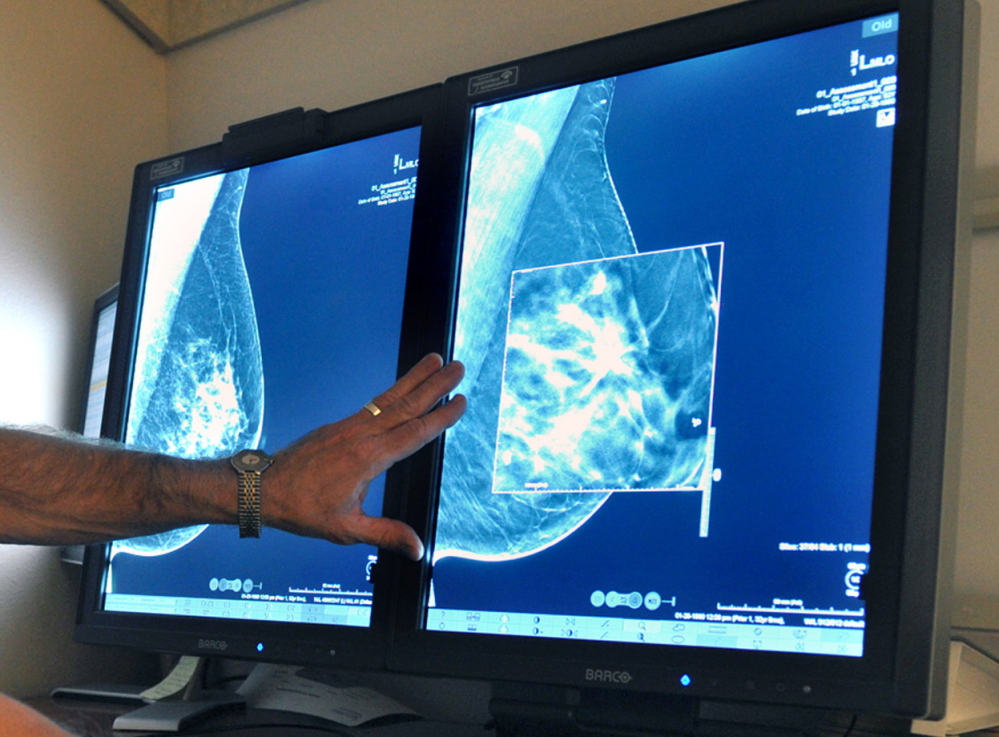A new study is questioning the way the medical community typically defines and treats the earliest stage of breast cancer.
An analysis found that “ductal carcinoma in situ,” which typically shows up on mammograms, should be considered an early form of breast cancer, not just a precursor to cancer as it is frequently described, according to a paper published Thursday in The Journal of the American Medical Association Oncology.
The researchers, who analyzed existing data on more than 100,000 women treated for DCIS in the United States, found that women with DCIS are twice as likely to die from breast cancer compared to the general U.S. population.
However, women diagnosed and treated for DCIS have relatively low mortality rates from breast cancer – 1.1 percent after 10 years and 3.3 percent after 20 years – prompting questions about the best way to treat a patient after early detection and adding to concerns that the ability to detect the lesions through mammograms may be leading to unnecessary mastectomies.
However, age at diagnosis and ethnicity play a role.
Women diagnosed with DCIS before they were 35 years old were 17 times more likely to die from breast cancer within 10 years, and diagnosed black women were more than twice as likely as white women to die from breast cancer, according to the paper.
“There is a potential for chemotherapy to reduce the rates of death from DCIS, but for most women the mortality rate is too low to justify toxic therapy,” said Dr. Steven Narod of Women’s College Hospital in Toronto, Canada, the lead researcher.
FOCUS ON THE INDIVIDUAL WOMAN
One Maine specialist said any decision around treatment should be made on a case-by-case basis.
“It’s a huge issue. You don’t want to low-ball a woman, but you don’t want to overtreat, either,” said Dr. Tracey Weisberg, president of New England Cancer Specialists in Brunswick. “You need to focus on the individual woman. It isn’t cookbook.”
DCIS will be found in about 60,000 U.S. women this year, versus more than 230,000 women expected to be diagnosed with invasive breast cancer, according to the American Cancer Society. More women have been diagnosed with DCIS in recent years because of increased screening and better imaging techniques.
Standard treatment is lumpectomy followed by radiation, although some women choose to have the entire breast or even both breasts removed. The study found that radiation reduced chances for disease recurrence, but didn’t lower 20-year survival chances. That may lead some women to skip radiation, Narod said.
By contrast, the results may lead some young women and blacks to seek more aggressive treatment including chemotherapy, although that isn’t usually recommended when the death rate is less than 10 percent, he said.
An editorial accompanying the JAMA report said the analysis “fuels a growing concern that we should rethink our strategy for the detection and treatment of DCIS.”
The report’s findings “provide a compelling case that it is time for change,” wrote Dr. Laura Esserman, a surgeon and breast cancer oncology specialist at University of California, San Francisco. “Given the low breast cancer mortality risk, we should stop telling women that DCIS is an emergency and that they should schedule definitive surgery within two weeks of diagnosis.”
MORE DATA ALWAYS WELCOME
For the lowest-risk situations, Esserman wrote, possible treatment could be diet, exercise, moderate alcohol intake and avoiding certain hormone therapies. Treatment could also vary for premenopausal women and post menopausal women. High-risk cases should still be aggressively treated while new treatments are explored, she wrote.
Robin Long, who has led breast cancer survivor support groups for about 18 years, said patients and families always welcome more information.
“Those studies are just so, so important,” even if the information may cast doubt on the best way to treat a diagnosis. “Women have to make decisions in all areas of their life with conflicting information. Even when things aren’t clear, it’s important to women to have as much information as possible.”
Long said women getting their first diagnosis can be overwhelmed by the news and the medical decisions they face.
“It’s like you’re in shock,” she said. Her support group, for example, can send someone to accompany a patient to a doctor’s appointment just to take notes. Some hospitals offer “nurse navigators” for similar work. “Sometimes people want to do something really fast – ‘just get it out of me’ – that’s the first reaction. But there’s time to do that research.”
The Associated Press contributed to this report.
Send questions/comments to the editors.




Success. Please wait for the page to reload. If the page does not reload within 5 seconds, please refresh the page.
Enter your email and password to access comments.
Hi, to comment on stories you must . This profile is in addition to your subscription and website login.
Already have a commenting profile? .
Invalid username/password.
Please check your email to confirm and complete your registration.
Only subscribers are eligible to post comments. Please subscribe or login first for digital access. Here’s why.
Use the form below to reset your password. When you've submitted your account email, we will send an email with a reset code.